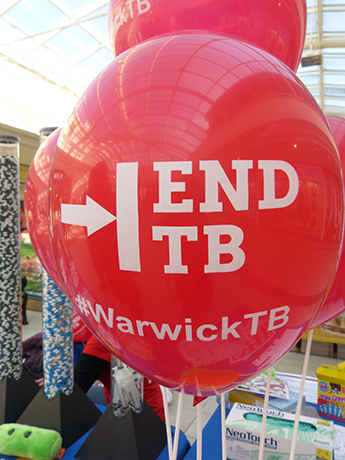Five things you need to know about TB

If you are under the impression that TB is a disease of the past – you are mistaken. Dr Elizabeth Fullam leads a multidisciplinary team of researchers in the Fullam Lab at the University of Warwick, studying the bacteria which cause tuberculosis (TB). Her group is carrying out urgent research into understanding the bacterium and finding new treatments for a disease which kills almost two million people worldwide every year. With antibiotic resistance on the rise, TB threatens to kill millions more.
Here’s five things you should know about TB:
1. Tuberculosis is a disease of the past and present
Tuberculosis is an ancient human pathogen and may be responsible for more deaths than any other infection in human history.
Magdalena Karlikowska, a PhD student in the Fullam Lab, explains: “TB is a very old disease. There is evidence of tuberculosis disease dating back to prehistoric humans and Egyptian mummies. TB was widespread in Europe the 19th and early 20th centuries, particularly amongst the poor, causing around 25% of all deaths. Improvements in sanitation, public health and vaccination led to a reduction in incidence rates.”
However, unfortunately this does not mean TB is a disease of the past and confined to the history books.
Magdalena points out: “Even in 2016 there were an estimated 10.4 million new cases of tuberculosis and 1.7 million deaths worldwide, more deaths than from both HIV and malaria combined. As it becomes easier to travel, TB is finding its way across the world and continues to pose a significant threat in the UK.”

2. The disease is caused by a bacterial infection
“Tuberculosis or TB, is caused by the bacteria Mycobacterium tuberculosis,” explains Dr Collette Guy, a postdoctoral researcher in the Fullam Lab. “It is an infectious disease which generally affects the lungs, but is also able to affect other parts of the body including the brain and the bones. Typical symptoms of TB include a severe cough, fever, night sweats, loss of appetite and weight loss, and if left untreated can be fatal.
“When someone who is ill with TB coughs or sneezes, the bacteria are spread into the air and you only need to inhale a few of these bacteria to become infected. It is possible to be infected with the bacteria that cause TB and not show any symptoms and this is called a latent TB infection.”
Dr Guy continues: “TB is an incredible pathogen that has evolved to be able to survive in humans for decades without causing disease and manages to avoid being killed by the human immune system. It is estimated that one third of the world’s population are currently latently infected with TB. Approximately 5-10% of individuals with latent TB will go on to develop an active TB infection in their lifetime, unless they are immuno-compromised – and in the case of HIV-TB co-infection this risk increases to 50%.
“Since tuberculosis is spread through the air it particularly affects those living in close proximity to each other, and therefore generally hits poorer communities.”
3. TB is complicated
TB is really difficult to spot, diagnose and treat. Dr Chris Furze, another researcher in the Fullam lab, explains: “The bacterium is slow growing which means that a sputum sample taken from a suspected case may take a number of weeks to process and get a positive diagnosis. Many countries still rely on using a microscope to see if TB bacteria are present, but this isn’t always reliable and only approximately 50% of TB cases are detected. More worryingly, we cannot diagnose drug-resistant strains using this method.
“New diagnostic methods, which can be used for point of care diagnosis of TB in resource-poor settings are urgently needed to be able to diagnose and treat TB quickly and stop the spread.”
4. There is an urgent need for new treatments
“Even though TB is an ancient disease, it wasn’t until 1882 that Dr Robert Koch identified the causative agent of tuberculosis to be a bacteria called Mycobacterium tuberculosis” explains Jonathan Fenn, a PhD student in the Fullam Lab.
“Despite finding the cause of TB it wasn’t until the 1940s that the first drugs to treat TB began to emerge. Whilst TB can be treated, the current treatment regime is complicated and requires a number of drugs to be taken, alongside each other, for six to nine months, often with unpleasant side effects. This has led to a number of people not completing the required course of antibiotics as they no longer feel ill from TB. It has resulted in a number of strains of TB that have become multi-drug or extensively-drug resistant which further complicates and prolongs treatment. In some cases there are no successful or effective drug treatments left.”
Postdoctoral researcher, Dr Mohd Syed Ahanger, adds: “Because of the lack of development in new TB drugs over the last 40 years, we have had to use and rely on the same drugs for TB for a very long time and now we are on the verge of a global catastrophe because of our reliance on these front-line TB antibiotics.”
5. Finding the solution
 The Fullam Lab uses a number of different approaches to investigate how the bacteria that cause TB use and process nutrients in the hope of using the information they discover to disrupt these essential processes as a future route to developing new drugs and diagnostics.
The Fullam Lab uses a number of different approaches to investigate how the bacteria that cause TB use and process nutrients in the hope of using the information they discover to disrupt these essential processes as a future route to developing new drugs and diagnostics.
Dr Fullam concludes: “There is an urgent need to understand how Mycobacterium tuberculosis is able to survive and cause infection. At the same time we need to add to our armoury and find new molecules with antibiotic properties so we have the potential to treat TB infections in the future.”
The Fullam Lab researchers all stress the importance of finding a new way of tackling this deadly disease before it is too late.
Researchers from the Fullam Lab will be out and about in Coventry, at the Herbert Museum and Art Gallery on Saturday 24 March and at Coventry Library on Tuesday 27 March, talking to the public about TB.
Published
23 March 2018
Terms for republishing
The text in this article is licensed under a Creative Commons Attribution 4.0 International License (CC BY 4.0).
Share

